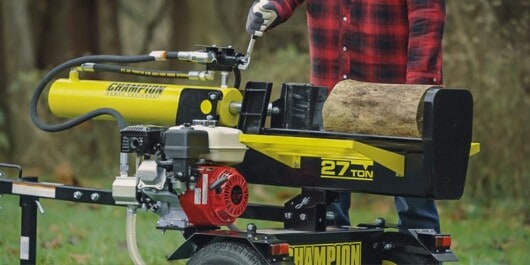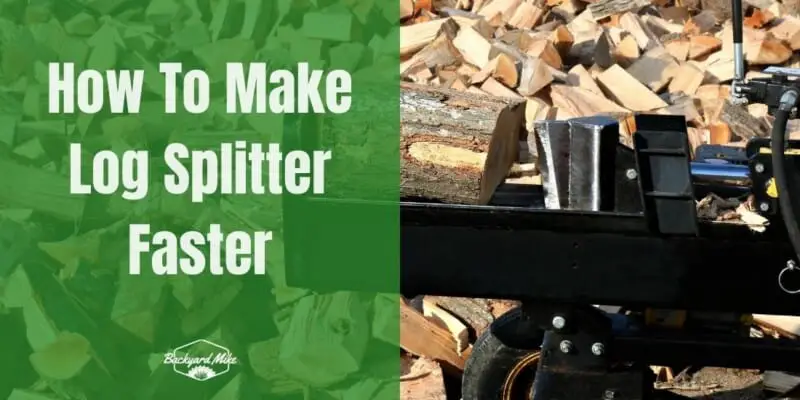Do you own a log splitter, and you’re wondering if there are ways you can make your log splitter slightly faster? If yes, then you’ve found yourself at the right place.
Making log splitter faster is all about increasing the cycle time of your log splitter. Some of the ways you can make your log splitter faster would be by upgrading your hydraulic fluid pump, implementing a 3-way valve, or purchasing a 2-stage hydraulic pump. Interestingly, you wouldn’t have to find how to speed up a log splitter if you buy a fast log splitter to begin with. Kinetic log splitters are the fastest ones in the market, and they can be as quick as 1 second per cycle.
In this article, you’ll get to know all about log splitters, how to make log splitter faster, what do you mean by the cycle time of a log splitter, what affects the cycle time of a log splitter, how to speed up cycle time on log splitter, and a lot more. Continue reading to get all the answers that you’re looking for.
What do you mean by the cycle time of a log splitter?
If you’ve ever tried to split wood by swinging an ax, you would probably agree that it’s a fairly labor-intensive task. Given the force and motion that you need to exert to split the wood, the task can be quite hectic. If you’re sick of cutting firewood via manual labor, you should consider investing in a high-quality log splitter. There are a few factors that play a key role in the splitting efficiency and speed of the log splitter, and one of them is the cycle time.
Cycle time is used to refer to the total time that it takes to complete an entire cycle of extending the splitting wedge from full retraction to full extension and back. It’ll be determined by the volume of fluid flow or the gallons per minute (GPM). If your log splitter has a spec cycle time of 15 seconds, then this is how long it takes for splitting a log. The faster the cycle time, the more work is done in less time.
A cycle time that is more than 15 seconds is considered to be largely unreliable. There are many ways the cycle time can be influenced. The size of the cylinder is usually associated with a slower cycle time. A log splitter that has a smaller cylinder will typically sacrifice some splitting force. Meanwhile, the type of hydraulic pump will also play a key role in the cycle time.
What affects the cycle time of a log splitter?
There are numerous things that can affect the cycle time of your log splitter, with the main factor being the GPM (Gallons Per Minute). This will be the biggest deciding factor in how fast the log splitter is and one of the main things that you need to look for when buying a new log splitter.
The hydraulic pump will pump the hydraulic fluid and is a major part of knowing what the GPM of your log splitter is. The type of hydraulic pump also plays a role in the overall cycle time of the log splitter.
Something that’s often overlooked on log splitters and cycle times is the number of cylinders included. Having a smaller cylinder will increase the cycle time, but you’ll be sacrificing some splitting force. When it comes to cycle times and splitting wood, you’ll have certain things that aren’t the log splitter’s fault, but they still affect the cycle time.
How to make log splitter faster
An average log splitter can cut wood way quicker than a manual ax. Despite using a log splitter, you’ll likely want to know how to speed up cycle time on log splitter. If you really wish to get the task done and over with quickly, you may want to speed up the machine’s cycle time. Here are the different ways how to make a log splitter faster.
Upgrade your hydraulic fluid pump
For increasing cycle time, you’ll require a bigger hydraulic fluid pump. However, this can also call for the need to increase the size of the hydraulic tank. This is for preventing the hydraulic fluid from overheating. For accommodating the increased hydraulic fluid flow, you’ll require bigger hydraulic hoses and larger supply lines.
Go for a 2-stage hydraulic pump
Another option would be to get a 2-stage hydraulic pump. When the return stroke doesn’t have any load, it’ll pump a larger volume at low pressure while moving the ram back quickly. The pressure increases, and the pump will switch back to high-pressure mode once the ram hits the wood. Essentially, a 2-stage hydraulic pump will speed up the entire process by requiring less power in moving the splitting ram.
Implement a 3-way valve
A 3-way valve will speed up the forward stroke while reducing the splitting force in proportions. The extra valve will consist of a standard port that connects to the other ports. Meanwhile, the second valve port will connect to the line that goes directly to the rod end of the cylinder. Coming to the remaining port, it’ll join into the line feeding the base end of the cylinder with a tee fitting.
Which type of log splitter is the fastest?
Undoubtedly, kinetic log splitters are the undoubted kings of speed when it comes to the speed of log splitters. They make a standard store-bought log splitter seem pretty average. Very few log splitters, including modified hydraulic log splitters, have a slim chance against kinetic log splitters.
A kinetic log splitter can be as quick as 1 second easily, which makes them the fastest log splitters on the market. The log splitter models on the lower end of kinetic splitters are around 3 seconds, so they are hard to beat in terms of speed.
Before rushing off and going to buy the first kinetic log splitter you come across, there are a few things that you need to consider. Depending on the model, they can lack certain force, which can be quite an issue, while some models can be slightly structurally weak.
The potential downsides of having a fast cycle time
There aren’t many downsides if your log splitter has a faster cycle time, and there are two potential downsides that you need to consider. One of them isn’t that much of a downside, but something to think about before you get a new log splitter.
If you’re going to be splitting wood by yourself, then having something fast could be a bit of a waste. Since it’ll split the logs quicker, you’ll be able to handle them in some cases, which means there is a lot of downtime for your machine.

The biggest downside of having a fast log splitter is that they are generally on the higher side of the budget. This is true for either upgrading your log splitter or purchasing a brand-new one. As they’re more expensive, they can end up hurting your wallet and make it not financially worth it for some users and their small budgets. If you’re able to afford a fast log splitter and think that you can handle the speed, then certainly you should go for it.
Conclusion
Thank you for reading. Hopefully, now you know a lot more about log splitters, how to make log splitter faster, what do you mean by the cycle time of a log splitter, what affects the cycle time of a log splitter, how to speed up cycle time on log splitter, and a lot more. Increasing the speed of a log splitter and making it faster is all about increasing the cycle time of your log splitter. Some of the ways you can make your log splitter faster would be by upgrading your hydraulic fluid pump, implementing a 3-way valve, or purchasing a 2-stage hydraulic pump. Interestingly, you wouldn’t have to find how to speed up log splitter if you buy a fast log splitter to begin with. Kinetic log splitters are the fastest ones in the market, and they can be as quick as 1 second per cycle.


